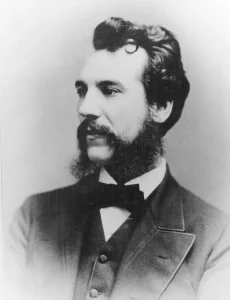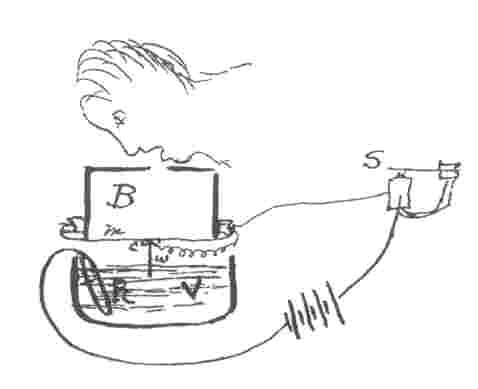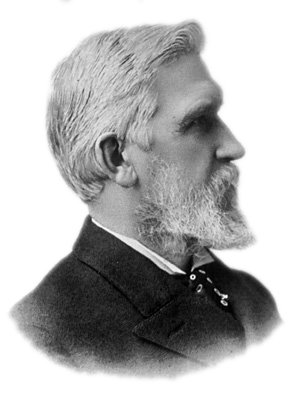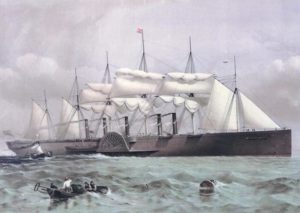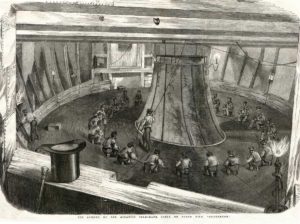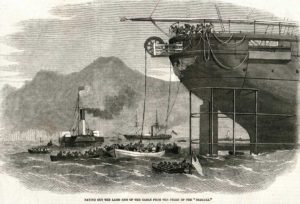Our history textbooks tell us that Alexander Graham Bell and his assistant Thomas A. Watson built and tested the world’s first working telephone on March 10, 1876. This statement is, broadly speaking, correct. Yet it can obscure what a crude instrument that first telephone really was, with its one end terminating in a tuning fork dunked in a bowl of pungent liquid, its other in a metal reed that functioned as the most rudimentary imaginable form of speaker. The device was unidirectional, which made holding an actual conversation over it an impossibility. If you breathed in when you leaned down to talk into the transmitting diaphragm, you would be rewarded with a lungful of fumes and a coughing fit. And as you used the telephone an ugly black deposit on the exposed wire in the bowl gradually ruined the connection, unless and until you scraped the toxic gunk away with a knife. The whole contraption looked and acted more like something from Dr. Frankenstein’s laboratory than a tool of modern communications.
Certainly Gardiner Greene Hubbard was thoroughly unimpressed with what he saw when he visited his protege’s workshop on March 13: he “seemed rather skeptical,” according to Bell’s laconic diary entry. Even now the telephone continued to strike him as a pointless distraction from the lucrative field of telegraphy. Seeing that they had probably lost the race to create a viable multiplex telegraph that improved on Joseph B. Stearns’s duplex design, Hubbard and Bell had recently agreed to pivot to what they called an “autograph” telegraph, which smacks of nothing so much as the fax machines of our own recent past. In an inadvertent echo of Samuel Morse’s original conception of the telegraph as a sort of electronic printing press, the autograph telegraph would allow an entire document to be “typeset” electronically and sent down the wire, using multiplexing to increase the transmission speed. To be sure, the idea was visionary in its way, but it was also most likely unachievable in the context of 1876, especially by one of Bell’s modest technical skills. At any rate, progress on it had been painfully slow. Yet Hubbard’s heart remained set on it.
Hubbard wrote to Bell shortly after his visit that he should devote himself exclusively to the autograph telegraph: “If you would work steadily on one thing [emphasis original] until you had perfected it, you would soon make it a success. While you are flying from one thing to another you may accidentally accomplish something, but you probably will never perfect anything.” Then he brought out his big gun: he persuaded his daughter Mabel to write to the lovelorn Bell that she could never think of marrying him until he had honored his agreement with her father to create the autograph telegraph. Bell was devastated. “I want to marry you, darling, because I love you,” he wrote in reply. “I wish to feel that you would marry me for the same reason.”
The ruthless pressure Hubbard was applying wasn’t quite enough to get Bell to abandon telephony altogether. But, not knowing how to package up his variable-resistance transmitter in some way that didn’t involve a lung-scalding bowl of acidulated water, he did lose faith on that front, returning to his older researches into the possibilities of unpowered magnetic-induction transmission. Within weeks, he and Watson had built a magnetic-induction telephone that could also transmit intelligible speech. Continuing with this method, which required no messy bowls of acidulated water and easily permitted a bi-directional conversation over a single wire, struck him as the most reasonable way forward. Bell would spend the rest of his fairly brief-lived career as an inventor in the fields of telegraphy and telephony chasing down the blind alleys of the autograph telegraph and the magnetic-induction telephone, never returning to his stroke of genius of March 10, 1876.

Much of the 1876 Philadelphia World’s Fair was devoted to the wonders of technology. Here we see the Machinery Hall, where a colossal Corliss steam engine dwarfs the full-size locomotives lined up in front of it. The telephone, the most important of all the technologies to make their debut at the fair, was seen only by a select few and attracted little press attention at the time.
The period between the American Civil War and World War II was the heyday of the World’s Fairs, international exhibitions of science, invention, and industry on a lavish scale. The very first World’s Fair to be held in the United States took place from May 10 to November 10 of 1876. It was presented in honor of the nation’s centennial in Philadelphia, the city where the Declaration of Independence had been signed. Hubbard used his connections to secure Bell a slot at a by-invitation-only demonstration of the latest techniques in telegraphy, which was to take place on June 25.
The day in question proved a brutally hot one; the air inside the temporary auditorium that had been erected on the fairgrounds was stifling. With no commercial record and no name recognition, the Bell Patent Association was relegated to the very last presentation of a long program of them. By the time Alexander Graham Bell took the stage, following such men of distinction as Elisha Gray, the audience of scientific, business, and political luminaries — among them was none other than William Thomson, the principal technical architect of the first transatlantic telegraph cable — was positively lethargic. While 2000 miles to the west Lieutenant Colonel George Custer was launching his ill-fated attack at Little Big Horn, Bell droned on about multiplex telegraphy and the autograph telegraph to a bored audience who had already heard enough of that sort of thing on this day. Then, just before he finished, he said that he would like to demonstrate another invention that was still “in embryo.”
Showing a flair for showmanship which his presentation to this point had never so much as hinted at, Bell invited Thomson to join him onstage, seating him before a table on which lay something that looked for all the world like a useless lump of iron. He told his august guinea pig to press the lump to his ear, then ran to a room behind the stage where its twin lay hidden. He began to declaim into it the famous soliloquy from Hamlet — “To be or not to be, that is the question” — in his dulcet Scottish brogue, itself a tribute to his family’s tradition of research in elocution. Onstage, Thomson’s face lit up in astonishment. Forgetting himself completely in the moment, the distinguished scientist jumped up and ran off like a schoolboy in search of Bell, leaving the audience perplexed as to what was going on here.
Bell’s next guinea pig made it clear to everyone. Emperor Pedro II of Brazil was something of a celebrity throughout the Americas, a portly, jolly man who looked and acted rather like Santa Claus, whose down-to-earth humanity belied his majestic station. “Dom Pedro,” as he was known, pushed the lump ever tighter to his ear and screwed up his face in concentration. Then he leaped up from his seat. “I hear! I hear!” he shouted in his broken English. Then, in Portuguese: “My God! It talks!” The room erupted in pandemonium. Forgetting about the heat and the long day stretching up to this point, the audience detained Bell for hours; every single one of them insisted on having his own chance to try out Bell’s magical telephone. The reaction finally convinced Hubbard that it was the telephone rather than Bell’s experiments in telegraphy that could make them both a fortune. He forgot everything he had ever said about his protege’s misplaced priorities. From this day forward, it would be full speed ahead on the telephone alone.
When he returned home to Britain, William Thomson said that the telephone had been the “most wonderful thing” he had seen at the Centennial Exhibition. Still not grasping that Bell’s invention was so revolutionary as to deserve a name of its own, he called it “the greatest marvel hitherto achieved by the electric telegraph,” noting as well that it had been “obtained by appliances of quite a homespun and rudimentary character.” (“I have never quite forgiven Sir William for that last sentence,” Thomas Watson would later remark with a wink.) But the public at large was slower to catch on, largely because not a single member of the mainstream press had attended the telephone’s coming-out party; journalists had all assumed that the day would contain nothing but incremental, fairly plebeian improvements on the existing technologies of telegraphy, interesting for those in the trade no doubt but hardly riveting for the general reader.
Still, word that something kind of amazing was afoot did slowly begin to spread. On August 3, Hubbard arranged to borrow a five-mile stretch of existing telegraph line connecting the towns of Mount Pleasant and Brantford in Ontario, and Bell conducted the first demonstration of his telephone to use outdoor wires that crossed a non-trivial distance. On October 9, again using a borrowed telegraph line, Bell and Watson had the first two-way conversation at a distance, speaking across the Charles River that separates Boston from Cambridge. On November 27, they communicated over the sixteen miles that separate Boston from Salem; they were able to extend the range this far by shifting from electromagnetic transmitters, relying upon a residual electrical charge from a battery, to more powerful permanent magnets that had no need at all for a battery.
On January 30, 1877, Bell was awarded a second telephony patent, one that much more fully described his design for a magnetic-induction telephone than had the previous one. By now the press was well and truly onto the story. “Professor Bell,” wrote the Boston Herald after the November 27 test, “doubts not that he will ultimately be able to chat pleasantly with friends in Europe while sitting comfortably in his Boston home.”
But such accommodating journalism was rare. Taking their lead from Western Union and the other established powers in the telegraph industry, most reporters treated the telephone as a novel curiosity rather than a supplement to — much less a threat to — the extant telegraph network. And there was in truth ample reason for skepticism. Even with the best permanent magnets Bell and Watson could find, the voices that came down their wires were whisper-faint. Ironically given Bell’s lifelong dedication to helping the deaf participate in the society around them, they were audible and decipherable only by people like him with excellent hearing. A comparison with that first transatlantic telegraph cable of 1858 is apt: these first telephones worked after a fashion, but they didn’t work all that well. In practice, most people tended to spend most of their time screaming “What did you say?” into them; the wonder the telephone initially provoked tended to shade with disarming speed into rank frustration. In his personal journal, Thomas Watson didn’t shy away from acknowledging the magnetic-induction telephone’s infelicities: it “would talk moderately well over a short line, but the apparatus was delicate and complicated and didn’t talk distinctly enough for practical use.”
Hubbard too showed signs of losing heart. At one point in late 1876, he reportedly asked Western Union whether they would be interested in buying Bell’s telephone lock, stock, and barrel for $100,000. He was turned down flat.
Bell lacked the requisite patience for the sort of slow, plodding laboratory work that might have improved his telephone, but he still needed to bring some money in for himself and Hubbard if he was to win the hand of the fair Mabel. So, he found an alternative to which his personality was more naturally suited: he hit the traveling-exhibition circuit with Watson in tow, crisscrossing the Northeast through much of the first half of 1877 like a boffinish P.T. Barnum. After his magic-lantern slideshow — the nineteenth century’s equivalent to Microsoft PowerPoint — he would present telephonic performances by brass bands, string quartets, opera singers, or church organs — the louder the racket they could make, the better — while his audience strained their ears to make sense of what they were hearing, or thought they heard. The disembodied human voices especially were fraught with sinister implications for many of those who assembled. In fact, the delicious thrill they provoked was doubtless a big part of the reason that audiences paid good money for a ticket; the seances of Spiritualism were becoming all the rage in the broader culture at the time. The Providence Star noted that it was “difficult, hearing the sounds out of the mysterious box, to wholly resist the notion that the powers of darkness are somehow in league with it.” “Had the hall been darkened,” wrote the Manchester Union, “we really believe some [from the audience] would have left unceremoniously.” The Boston Advertiser called the demonstration “weird”; the New York Herald declared it “almost supernatural.”
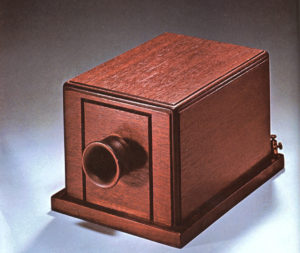
A Bell magnetic-induction “box” telephone from 1877. The cone mounted on the end served as both transmitter and receiver, necessitating some dexterous juggling on the part of the user.
The proprietors of the telephone are now prepared to furnish telephones for the transmission of articulate speech through instruments not more than twenty miles apart. Conversation can easily be carried on after slight practice and with occasional repetition of a word or sentence. On first listening to the telephone, though the sound is perfectly audible, the articulation seems to be indistinct. But after a few trials the ear becomes accustomed to the peculiar sound.
— The first advertisement for the Bell telephone, May 1877
By the late spring of 1877, Bell and Watson’s roadshow showed signs of running out of steam. It seemed they had to put up or shut up: the partners needed either to make a serious attempt to commercialize the telephone or just move on with their lives. After much debate, they chose the former course. That May, they signed their first customer, an enterprising banker named Roswell C. Downer, who paid for a telephone line connecting his home with his office. This harbinger of the modern condition was followed by no fewer than 600 more of his ilk by August 1. All of the connections were point-to-point setups linking one telephone to exactly one other telephone. But one decision the partners made would prove crucial to the eventual development of a more flexible telephone network: they leased telephones rather than sold them to their customers, and retained ownership and control of the cables binding them together as well. To state the case in modern terms, the telephone industry was to be a service rather than a hardware provider.
Each of these early telephones looked like a block of wood with a hole on one end and some wire sticking out the other. After shouting into the hole, one then had to shift it quickly to one’s ear to catch the response. “When replying to communication from another, do not speak too promptly,” pleaded the instruction manual. “Much trouble is caused from both parties speaking at the same time. When you are not speaking, you should be listening.” Being completely unpowered, these first telephones had no ability to ring; if someone didn’t happen to be standing at the other end when you shouted down the line, you were just out of luck. They were so heavy that using them was a veritable workout; Thomas Watson described the experience as akin to holding a suitcase up to one’s ear for minutes at a time. And yet there was a reasonably substantial group of people willing to pay for the dream of being in instant voice communication with others a considerable distance away, however circumscribed the reality of the telephone in service might have been.
The summer of 1877 was an exciting one for Alexander Graham Bell. On July 9, the Bell Telephone Company was formed, superseding the old Bell Patent Association. Two days later, he was finally allowed to marry Mabel. And on August 1, the Bell Telephone Company issued its first 5000 shares: 1497 of them to the mostly silent partner Thomas Sanders; 1497 to the young woman who was now known as Mabel Bell; 1387 to Gardiner Hubbard; 499 to Thomas A. Watson; 100 to Hubbard’s wife; ten to Hubbard’s brother; and all of ten shares to Bell himself, who in the throes of his newlywed bliss had signed all of the rest that he had coming over to his wife.
Shortly thereafter, Alexander Graham and Mabel Bell sailed for Britain, both to enjoy an extended honeymoon — it was Bell’s first return to his homeland since his emigration seven years before — and to act as ambassadors for the telephone on the other side of the Atlantic. In the latter capacity, they demonstrated it to Queen Victoria on January 14, 1878. There were some problems getting the connection going over the borrowed telegraph wire, and the queen’s attention began to wander. But suddenly Bell heard through the gadget the voice of a woman he had hired to sing “Kathleen Mavourneen,” one of the queen’s favorite ballads. In his excitement, he reached out and grabbed her by the arm. Everyone in the room gasped — but Queen Victoria didn’t even seem to notice, merely pressed the box to her ear and listened with a rapt expression. She wrote in her diary that night that Bell’s telephone was “most extraordinary.”
The audience with the queen created a widespread frisson of excitement over the telephone in Britain the likes of which had ironically not yet been seen in its birth country, where its thunder had recently been stolen by the announcement of Thomas Edison’s phonograph. Toy telephones became popular on Britain’s high streets. “Wherever you go,” wrote Mabel Bell in a letter back home to her mother, “on newspaper stands, at news stores, stationers, photographers, toy shops, fancy-goods shops, you see the eternal little black box with red face, and the word ‘Telephone’ in large black letters. Advertisements say that 700,000 have been sold in a few weeks.” If Bell Telephone could have leased anywhere near as many of the real thing back in the United States, everyone involved would have been thrilled.
But the harsh truth was that, even as the Bells were doing their public relations overseas, the company that bore their name was floundering in the domestic market. Many or most of the customers who had initially signed up in such gratifying numbers were dissatisfied by the underwhelming reality of their telephones, and no amount of patiently pedantic instruction manuals were going to get them to love a device that just didn’t work all that well. Worst of all, there was now a formidable competitor about to enter the field with a telephone much better than the one being peddled by Bell, thanks to the inventive genius of one Thomas Edison.
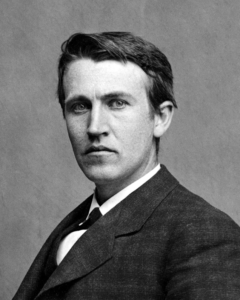
Thomas Edison at about age 30, when he was active in telegraphy and telephony and also in the process of inventing the phonograph.
Thomas Alva Edison was born in Ohio on February 11, 1847, the seventh and last child of parents who had just been driven out of British Canada for backing an insurrection against the provincial government there. When his father wasn’t rebelling, he was an odd-jobber and striver whose schemes never quite seemed to pan out. His mother was a former schoolteacher; almost all of the limited education Edison received came from her in the family home. Already at age twelve, he started riding the rails, working as a newsboy on trains. Showing the same entrepreneurial streak as his father but demonstrating more ability to turn his schemes into profits, he soon became a full-fledged mobile shopkeeper, buying snacks, books, and magazines cheap and selling them at a mark-up to passengers. He even published his own newspaper for a time from a compartment on the train with the help of an old printing press he had acquired. But it was the telegraph houses that stood everywhere the trains traveled that really captured the teenage Edison’s interest.
He happened to be sitting on a station platform one day when he saw a young boy wander onto the tracks in front of an approaching locomotive. Edison leaped to the rescue, successfully. The boy’s father happened to be the telegraph master at the station. The grateful man agreed to teach Edison some of the basics of telegraphy, and also lent him a number of books on the subject. Edison studied the description of Morse Code found therein with fanatical dedication — “about eighteen hours a day” was his own claim later in life — and got his first paying gig as a telegraph operator in Stratford Junction, Ontario, at the age of sixteen.
He quickly became a star among the telegraph fraternity. The speed with which he could decode messages coming down the wire became legendary; if one of his colleagues was sick, he could do this other’s job as well as his own, decoding two separate messages from two skilled senders simultaneously. And, because even brainy boys will be boys, he became equally legendary for his practical jokes. One of his favorites combined a wet floor with an induction coil to give his fellow operators a very unpleasant electrical shock as soon as they sat down in front of their Morse keys.
As that anecdote would indicate, Edison was fast becoming more than just a skilled end-user of the telegraph. He was fascinated by electrical technology in the abstract in a way that Alexander Graham Bell would never be; he lived and breathed it, experimenting and tinkering endlessly whenever he wasn’t on duty in a telegraph house. He applied for his first patent at age 21, for an automated vote recorder that he imagined would be used by the United States Congress; each representative need only push either the aye or the nay button installed at his seat, and the results would be automatically tabulated and displayed on a big dial mounted on the wall. But no one in the capital proved to be interested in it — because, as it was belatedly explained to Edison, the slow, inefficient method of voting that was currently used was actually an essential part of the legislative process, providing as it did ample opportunities to lobby, whip, and negotiate for votes. He took away from the experience a lesson that would never leave him: an inventor who wishes to be successful must ask what the people want, and invent that thing instead of the thing that makes him feel clever. With this lesson in hand, Edison would go on to become history’s archetype of the commercially successful inventor.
Though he was rough-hewn in demeanor and largely uneducated in anything other than the vagaries of mechanisms and circuits, Edison nonetheless displayed a peculiar ability to talk to moneyed men of business and win their support. In 1869, he retired from his career as a telegraph operator and became a sort of telegraphy consultant, helping his clients to improve their systems and processes. In 1874, he scored his first major triumph as an inventor of things that people really wanted, and crushed the first telegraphy dream of Alexander Graham Bell in the process: he patented a quadriplex telegraph with the ability to double again the throughput of Joseph B. Stearns’s recently introduced duplex system. Unlike Bell’s design, which stamped each of its signals with a unique frequency on the sending end and used these as a way to sort them out again on the receiving end, Edison’s system combined Stearns’s innovations with differing electrical polarities that served as another way of separating signals from one another. Most importantly, his system consistently worked, which was more than could ever be said for Bell’s.
The quadriplex telegraph catapulted him into the next stage of his career. In the spring of 1876, Edison moved into his soon-to-be-famous laboratory in Menlo Park, New Jersey, from which he would invent so many of the trappings of our modern world. Later that year, as we’ve seen, press notices about Bell’s magnetic-induction telephone began to appear. Edison had been very hard of hearing since boyhood, which meant that Bell’s invention as currently constituted was useless to him. So, he decided to make a better telephone, one that even he would be able to use without difficulty.
There no longer remained any mystery about the best theoretical approach to such a goal. Clearly the key to a louder telephone was the use of a variable-resistance transmitter instead of one that relied on magnetic induction; this Bell himself had demonstrated before losing heart. Bell had given up because he didn’t know of any substances other than acidulated water whose resistance could be made to vary in tandem with the vibrations of a diaphragm that was being struck by sound waves issuing from a human mouth. But Edison was possessed of both a much wider range of electrical knowledge and a methodical patience which eluded the high-strung Bell.
Edison made his own experimental telephone, and throughout most of 1877 used it to test many solid or semi-solid materials, keeping careful notes on the results. He tried paper, lead, copper, graphite, felt, and platinum among other substances, all of them in countless forms, combinations, and configurations, conducting over 2000 separate trials in all. In the end, he wound up back at the very first material he had tested: carbon, in the form of lampblack — i.e., residual soot scraped from a lamp or chimney. Lampblack was, he judged, as close as a solid could come to the properties of acidulated water.
Edison’s final design for a variable-resistance transmitter used a cone with a thin metal diaphragm installed at its base, much like Bell’s extant telephones. But instead of a magnet, his diaphragm rested atop a sealed container of lampblack, through which a powered electrical circuit flowed. As the diaphragm vibrated in rhythm with the user’s words, its movements varied the resistance of this circuit to create a facsimile of the sound wave in electrical current — just as had the acidulated water in Bell’s experiment of the previous year, but in a far more practical and reliable way. An electromagnet and diaphragm, designed by a prolific telegraph engineer and occasional associate of Edison named George Phelps, served as a receiver at the other end of the line in lieu of Bell’s metal reed, giving much better fidelity. Edison’s telephone did have the disadvantage of being unidirectional; a two-way conversation required two wires, each fitted with its own transmitter and receiver. Then again, such a setup meant that the user no longer needed to keep moving the telephone between mouth and ear; she could speak and listen at the same time, and do the latter without straining her ears.
All told, it was a tremendous breakthrough, one with the potential to increase not only the volume but also the range of the telephone. Edison applied for a patent on his variable-resistance transmitter already on April 27, 1877, when he was still very much in the process of inventing it. After much back and forth, the patent was finally granted in February of 1878. By the time it was, Edison himself had become famous, thanks not to the telephone but the phonograph, which he had been working on concurrently with his experiments in telephony.

An early Western Union telephone. The user spoke into the round piece on the left, whilst holding the star-shaped receiver on the right up to her ear.
Already two months before the final patent on Edison’s transmitter was issued, Western Union cut a deal with the inventor for the right to use it, forming a new subsidiary called the American Speaking Telephone Company to put it into service. A David-and-Goliath fight was now in the offing between Bell Telephone and Western Union. The latter corporation was in many ways a model for the other great trusts in this emerging Gilded Age of American business; for all intents and purposes it owned telegraphy writ large in the United States, as it seemed it now intended to own telephony. To make that happen, it had a market capitalization of $41 million (the equivalent of $1.4 billion in 2022 currency), net annual profits of more than $3 million, and established rights-of-way for its wires in every corner of the nation. And now it had a telephone that was by any objective standard vastly superior to the one being peddled by its puny rival.
The telephones which Western Union began leasing to customers in 1878 were the first in commercial service to be recognizable as such things to modern eyes, having separate attachments for talking and listening. A variable-resistance telephone of course required a powered circuit; in lieu of expensive and maintenance-heavy batteries, the end-users provided this power via elbow grease, by cranking from time to time a magneto attached to the telephones. It was a small price to pay for a device that was ergonomically superior and, most importantly of all, louder than anything that Bell Telephone could offer. For the first time, it was possible to have something resembling an ordinary conversation using these telephones.
Justifiably unnerved by these developments, Gardiner Hubbard asked a businessman named Theodore N. Vail to take over as head of Bell Telephone. Only 32 years old at the time he agreed to do so, Vail had, like Thomas Edison, gotten his start as an ordinary telegraph operator. But his genius ran in the direction of finance and management rather than the nuts and bolts of technology itself. He left his prestigious and well-paid post as head of the Railway Mail Service largely because he was bored with it and wanted a challenge. Whatever else one could say about it, Bell Telephone certainly qualified on that front.
After arriving at the company’s recently opened headquarters in New York City, Vail sat down to consider what he had gotten himself into. He realized that victory in the war with Western Union would have to come through the courts; as matters currently stood, Bell Telephone had no chance of winning via the free market alone. The patent situation was confusing to say the least. Alexander Graham Bell had patented the first working telephone, but had mentioned the principle of variable resistance that could make the telephone truly usable only in an addendum hand-scrawled in the margin of that patent. And now Thomas Edison instead of Bell had patented the carbon transmitter that was the key to a practical variable-resistance telephone, suitable for mass production and deployment. It seemed that Bell Telephone and Western Union each owned half of the telephone. This clearly wouldn’t do it at all.
So, Vail had Thomas Watson troll through the records at the patent office, looking for some way out of this impasse. In an incredible stroke of luck, he found just what they needed. On April 14, 1877 — thirteen days before Edison had filed a patent application for his variable-resistance transmitter — a German immigrant, janitor, and amateur inventor named Emile Berliner had filed for a patent caveat on a variable-resistance transmitter of his own. It used a different approach than Edison’s design: a wire inside it was only loosely screwed onto its terminal, which allowed the point of contact to vibrate in tandem with the diaphragm mounted above the wire, thus varying the resistance of the circuit. Berliner’s design was, everyone could agree, nowhere near as effective as Edison’s finalized carbon transmitter — but it had come first, and that was the important thing. Vail tracked down Berliner, who was still pushing a broom for a living, and hired him at a generous salary in return for the rights to his patent caveat. Vail’s intention was never to put Berliner’s transmitter into production, but rather to create a plausible legal argument that the principle of the variable transmitter, like all of the other aspects of a practical telephone, was now the sole intellectual property of the Bell Telephone Company. The new variable-resistance telephones which Bell began sending to its customers as soon as it had acquired the rights to Berliner’s transmitter actually cloned Edison’s carbon-transmitter design.
On September 12, 1878, the Bell Telephone Company filed for an injunction against Western Union’s telephones in the Circuit Court of the United States for the District of Massachusetts. Following some preliminary skirmishing, Western Union, whose telegraphy business still dwarfed that of telephony, decided on November 10, 1879, that the telephony sideshow just wasn’t worth the trouble. It agreed to give up all of its claims to telephone technology and to get out of the telephone business altogether in return for 20 percent of all of its rival’s earnings from telephony for the lifetime of the patents around which the whole conflict had revolved. It was the Gilded Age in a nutshell: one established monopolist politely made space for another, would-be monopolist in a related but separate field.
But it wasn’t the end of the disputes over the origins of the telephone. Far from it: over the course of the following decade, Bell Telephone beat back some 600 separate legal challenges to its monopoly — including one from Elisha Gray, striking out on his own from Western Union, the company he had co-founded. The record of court filings came to fill 149 thick volumes. One of the cases went as far as the Supreme Court in March of 1888, where it was won by Bell Telephone by the thinnest of possible margins: the vote was four to three in favor of the validity of the Bell patents. By this point, however, the point verged on becoming moot: Bell Telephone now had a well-nigh unassailable head start over any potential competition, and the patents were due to expire in a few years anyway.
Alexander Graham Bell himself regarded the realities of the telephone business with ever-increasing distaste, and felt himself ever more estranged from the enterprise that bore his name. And to a large extent, the feeling was mutual: he had disappointed and angered his ostensible partners in Bell Telephone by, as they saw it, deserting them in their time of greatest need. He had been entirely absent from the American scene from August of 1877 until September of 1878, when he grudgingly agreed to return from Britain to act as a witness in court. “Business is hateful to me at all times,” he wrote to Gardiner Hubbard on one occasion. “I am sick of the telephone and [wish to] have done with it altogether, excepting as a plaything to amuse my leisure moments,” he wrote on another. “Why should it matter to the world who invented the telephone, so long as the world gets the benefit of it?” he wrote on yet a third occasion. “I have not kept up with the literature of telephonic research,” he remarked dismissively when he did finally turn up in person for the legal proceedings. These were not the messages which the men behind a company girding for the battle for its life — a company with the petulant messenger’s name on the marque — wished to hear.
Alexander Graham and Mabel Bell gradually cashed out of said company between 1879 and 1883. They were left wealthy, but not extraordinarily so. Ditto Sanders, Hubbard, and Watson, all of whom likewise sold most of their shares in Bell Telephone before the company was ten years old. “No mighty, self-perpetuating fortunes came out of telephony in America,” noted the historian John Brooks in 1975. “No counterpart to a Ford, Rockefeller, or Duke now survives as a ‘telephone heir.'” But this shouldn’t be construed to imply that the telephone didn’t make an enormous amount of money for Bell Telephone and others in the decades after its founders left the scene.
Alexander Graham Bell continued for the rest of his life to split his time between invention — he dabbled with somewhat mixed results in everything from medical technology to aviation, nautical transport to cinema — and his passion for improving the lot of the deaf. Mabel Bell provided a suitable epitaph when he died in 1922 at the age of 75: “He is big enough to stand as he is, very imperfect, lacking in things that are lovely in other men, but a good big man all the same…” It is true that, in a juster or at least more painstakingly accurate world, we might all agree to call the telephone a joint triumph, to be credited not only to Bell but to Edison, Gray, and perhaps some worthy others whose names have appeared not at all or only in passing in these articles. But history in the world we do have doesn’t like to become muddied with so many equivocations. Thus it has chosen to credit the telephone to Alexander Graham Bell alone. And, if one man must be chosen, he is as good a choice as any.
(Sources: the books Alexander Graham Bell and the Conquest of Solitude by Robert V. Bruce, Alexander Graham Bell: The Life and Times of the Man Who Invented the Telephone by Edwin S. Grosvenor, Reluctant Genius: Alexander Graham Bell and the Passion for Invention by Charlotte Gray, Telephone: The First Hundred Years by John Brooks, and The Wizard of Menlo Park: How Thomas Alva Edison Invented the Modern World by Randall E. Stross. Online sources include Bob’s Old Phones by Bob Estreich and “George M. Phelps” by John Casale on his website Telegraph History.)



